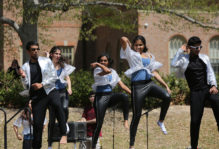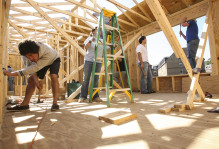Putting the Green in Green and Gold
At William & Mary, we take sustainability seriously, and are continually looking for ways to green our campus. From our academic program to our dining halls, every aspect of William & Mary is getting more environmentally friendly.
Our Student Environmental Action Coalition is one of the largest student run organizations and has been increasingly effective at greening our school. When the school was unable to provide outdoor recycling on old campus, SEAC members worked to empty the containers themselves (with the help of one of our service fraternities). Their current campaigns include working to fight an environmentally disastrous coal plant from being built a short distance from campus and working to bring more sustainable energy sources to campus. Students are encouraged by SEAC to use CFL light bulbs, reusable coffee mugs, and each room comes with a recycling container to help students recycle.
I have particular insight into the changes in the dining halls, as I am a member of the Food Services Advisory Committee, a group of students and administrators that work together to advise our dining services contractor on meal plans and other issues related to the dining halls. There has been massive improvement over the past two years relating to almost every aspect of their operation. We compost nearly all of our leftover food to help reduce waste and produce organic fertilizer, have gone trayless to reduce dishwashing waste, and even instituted a reusable to-go container program so that students can eat outside of the dining halls without lots of material waste. When logistically possible, our dining halls purchase locally grown foods. Our condiment containers are centrally located, so there is no waste from individual containers on every table. And the best part is that many of these projects were funded through outside grants, so most of the time, these changes haven’t even cost the College anything. Some even save money, as less material waste means cheaper goods and less money spent.
Other projects include working to make the Lodges into an “eco-village” which will model the latest in sustainable housing, an initiative to put solar panels on the roof of our physics building, and the Do One Thing program by members of the Business School, which focuses on encouraging students to find one new thing they can do to be environmentally friendly each day. All of our newly constructed residence halls are LEED certified and the older ones are frequently updated to make them more environmentally efficient where necessary. Appliances in the residence hall kitchens are all Energy Star rated and the washers are specially designed to require less energy and water. The Committee on Sustainability—an advisory group formed of students, professors, and administrators—meets monthly and many of its subgroups meet weekly to find new ways to make the school greener. They fund various projects and initiatives, including an investigation into our recycling practices which saved the College $40,000 and helped us recycle more at the same time, proving that green doesn’t have to come at the expense of gold.
For more information, check out the following links:
The school’s sustainability website, with links to the Committee on Sustainability and various initiatives to green our campus
The SEAC homepage with links to its various campaigns and tips on what you can do.
The blog of our Sustainability Fellow, an official campus position dedicated to making the College greener.
Matt Herdman
Class of 2012
Comments are currently closed. Comments are closed on all posts older than one year, and for those in our archive.



Going green is not such a bad idea, as long as you don’t shove it down our throat. But if you are selling the idea to promote the evils of carbon gases and carbon credits, you are playing in the hands of elites whose only goal is to tax and control. For god sake, Al Gore is the go-green poster child. Have you ever looked at Al’s carbon footprint?